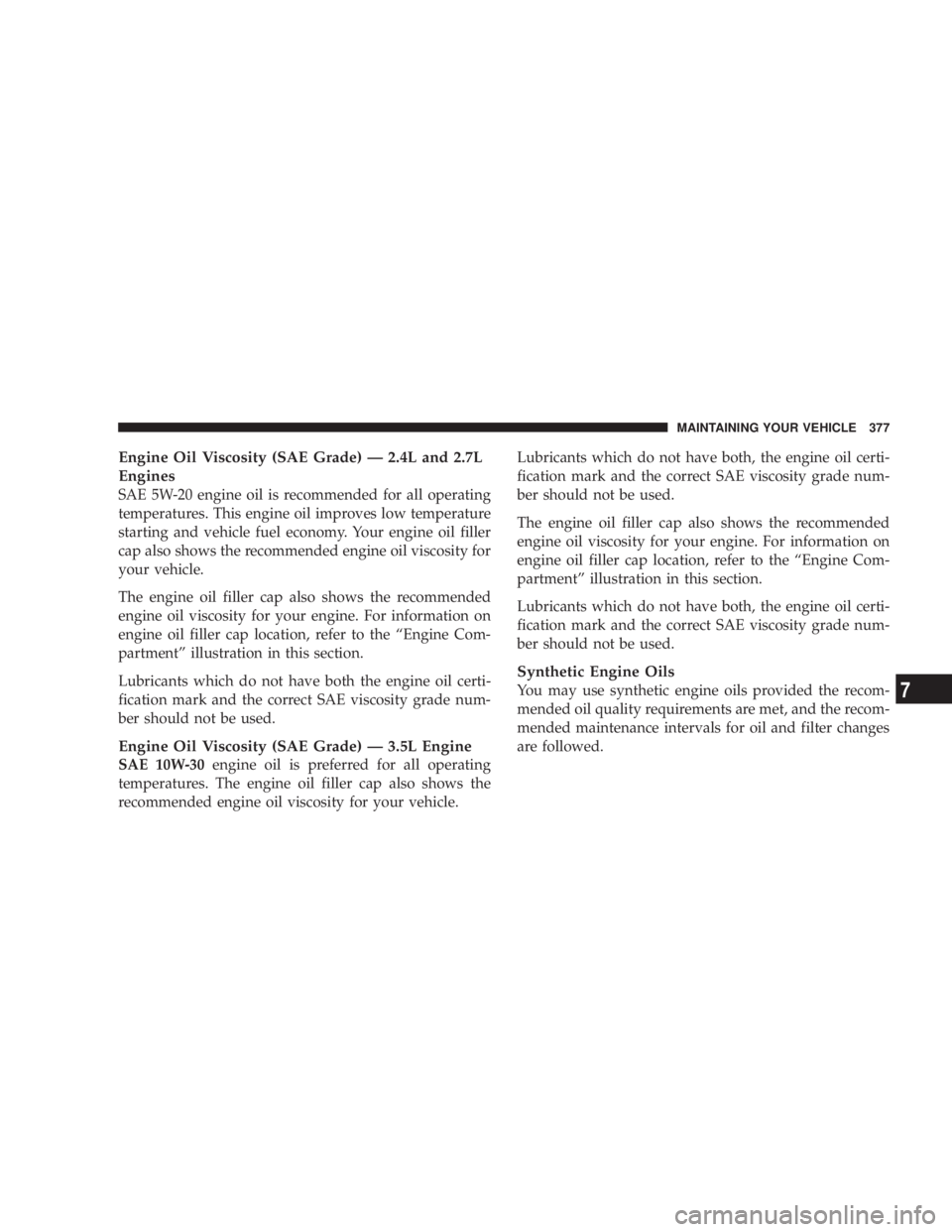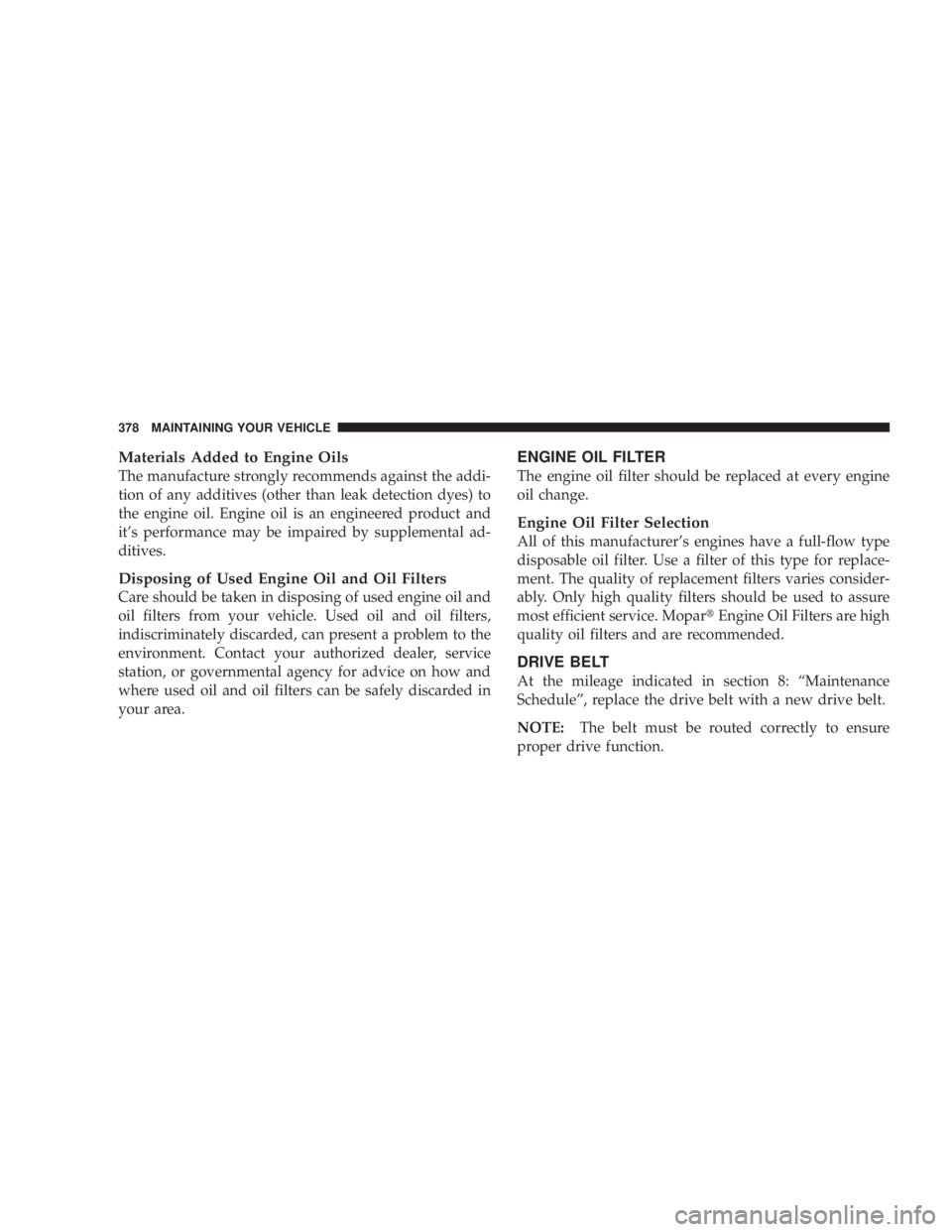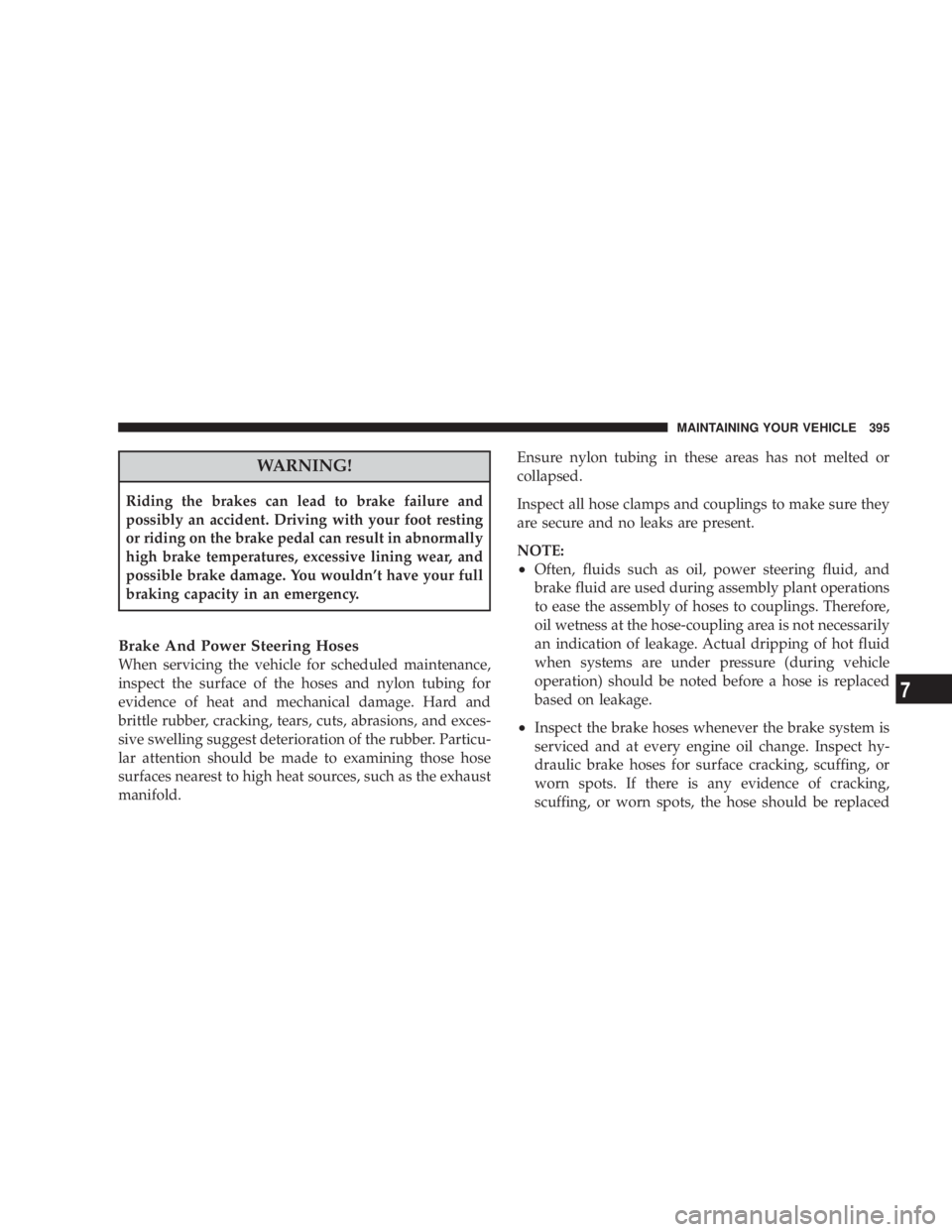Page 379 of 467

Engine Oil Viscosity (SAE Grade) Ð 2.4L and 2.7L
Engines
SAE 5W-20 engine oil is recommended for all operating
temperatures. This engine oil improves low temperature
starting and vehicle fuel economy. Your engine oil filler
cap also shows the recommended engine oil viscosity for
your vehicle.
The engine oil filler cap also shows the recommended
engine oil viscosity for your engine. For information on
engine oil filler cap location, refer to the ªEngine Com-
partmentº illustration in this section.
Lubricants which do not have both the engine oil certi-
fication mark and the correct SAE viscosity grade num-
ber should not be used.
Engine Oil Viscosity (SAE Grade) Ð 3.5L Engine
SAE 10W-30 engine oil is preferred for all operating
temperatures. The engine oil filler cap also shows the
recommended engine oil viscosity for your vehicle. Lubricants which do not have both, the engine oil certi-
fication mark and the correct SAE viscosity grade num-
ber should not be used.
The engine oil filler cap also shows the recommended
engine oil viscosity for your engine. For information on
engine oil filler cap location, refer to the ªEngine Com-
partmentº illustration in this section.
Lubricants which do not have both, the engine oil certi-
fication mark and the correct SAE viscosity grade num-
ber should not be used.
Synthetic Engine Oils
You may use synthetic engine oils provided the recom-
mended oil quality requirements are met, and the recom-
mended maintenance intervals for oil and filter changes
are followed. MAINTAINING YOUR VEHICLE 377
7
Page 380 of 467

Materials Added to Engine Oils
The manufacture strongly recommends against the addi-
tion of any additives (other than leak detection dyes) to
the engine oil. Engine oil is an engineered product and
it's performance may be impaired by supplemental ad-
ditives.
Disposing of Used Engine Oil and Oil Filters
Care should be taken in disposing of used engine oil and
oil filters from your vehicle. Used oil and oil filters,
indiscriminately discarded, can present a problem to the
environment. Contact your authorized dealer, service
station, or governmental agency for advice on how and
where used oil and oil filters can be safely discarded in
your area. ENGINE OIL FILTER
The engine oil filter should be replaced at every engine
oil change.
Engine Oil Filter Selection
All of this manufacturer's engines have a full-flow type
disposable oil filter. Use a filter of this type for replace-
ment. The quality of replacement filters varies consider-
ably. Only high quality filters should be used to assure
most efficient service. Mopar t Engine Oil Filters are high
quality oil filters and are recommended.
DRIVE BELT
At the mileage indicated in section 8: ªMaintenance
Scheduleº, replace the drive belt with a new drive belt.
NOTE: The belt must be routed correctly to ensure
proper drive function.378 MAINTAINING YOUR VEHICLE
Page 383 of 467

To minimize the possibility of catalyst damage:
² Do not shut off the engine or interrupt the ignition
when the transaxle is in gear and the vehicle is in
motion.
² Do not try to start the engine by pushing or towing the
vehicle.
² Do not idle the engine with any ignition coil connec-
tors disconnected for prolonged periods.
MAINTENANCE-FREE BATTERY
You will never have to add water, nor is periodic main-
tenance required.
NOTE: The battery is stored in a compartment behind
the left front fender and is accessible without removing
the tire and wheel. Remote battery terminals are located
in the engine compartment for jump-starting.
To access the battery, turn the steering wheel fully to the
right and remove the inner fender shield. WARNING!² Battery fluid is a corrosive acid solution and can
burn or even blind you. Don't allow battery fluid
to contact your eyes, skin, or clothing. Don't lean
over a battery when attaching clamps. If acid
splashes in eyes or on skin, flush the area imme-
diately with large amounts of water.
² Battery gas is flammable and explosive. Keep
flame or sparks away from the battery. Don't use a
booster battery or any other booster source with an
output greater than 12 volts. Don't allow cable
clamps to touch each other.
² Battery posts, terminals, and related accessories
contain lead and lead compounds. Wash hands
after handling. MAINTAINING YOUR VEHICLE 381
7
Page 389 of 467

Keep the blade rubber out of contact with petroleum
products such as engine oil, gasoline, etc.
NOTE: Always refer to the wiper blade packaging for
specific installation instructions. Many wiper blade re-
placements fit multiple vehicles.
WINDSHIELD WASHERS
NOTE: Refer to the appropriate ªEngine Compartmentº
diagram in Section 7 for the location of the windshield
washer fluid reservoir.
The fluid reservoir for the windshield washers is located
in the engine compartment. Be sure to check the fluid
level in the reservoir at regular intervals. Fill the reservoir
with windshield washer solvent (not radiator antifreeze)
and operate the system for a few seconds to flush out the
residual water. WARNING!Commercially available windshield washer solvents
are flammable. They could ignite and burn you. Care
must be exercised when filling or working around
the washer solution.
EXHAUST SYSTEM
The best protection against carbon monoxide entry into
the vehicle body is a properly maintained engine exhaust
system.
If you notice a change in the sound of the exhaust system
or if exhaust fumes can be detected inside the vehicle or
when the underside or rear of the vehicle is damaged,
have a competent technician inspect the complete ex-
haust system and adjacent body areas for broken, dam-
aged, deteriorated, or mispositioned parts. Open seams
or loose connections could permit exhaust fumes to seep MAINTAINING YOUR VEHICLE 387
7
Page 397 of 467

WARNING!Riding the brakes can lead to brake failure and
possibly an accident. Driving with your foot resting
or riding on the brake pedal can result in abnormally
high brake temperatures, excessive lining wear, and
possible brake damage. You wouldn't have your full
braking capacity in an emergency.
Brake And Power Steering Hoses
When servicing the vehicle for scheduled maintenance,
inspect the surface of the hoses and nylon tubing for
evidence of heat and mechanical damage. Hard and
brittle rubber, cracking, tears, cuts, abrasions, and exces-
sive swelling suggest deterioration of the rubber. Particu-
lar attention should be made to examining those hose
surfaces nearest to high heat sources, such as the exhaust
manifold. Ensure nylon tubing in these areas has not melted or
collapsed.
Inspect all hose clamps and couplings to make sure they
are secure and no leaks are present.
NOTE:
² Often, fluids such as oil, power steering fluid, and
brake fluid are used during assembly plant operations
to ease the assembly of hoses to couplings. Therefore,
oil wetness at the hose-coupling area is not necessarily
an indication of leakage. Actual dripping of hot fluid
when systems are under pressure (during vehicle
operation) should be noted before a hose is replaced
based on leakage.
² Inspect the brake hoses whenever the brake system is
serviced and at every engine oil change. Inspect hy-
draulic brake hoses for surface cracking, scuffing, or
worn spots. If there is any evidence of cracking,
scuffing, or worn spots, the hose should be replaced MAINTAINING YOUR VEHICLE 395
7
Page 399 of 467

WARNING!² Overfilling the brake fluid reservoir can result in
spilling brake fluid on hot engine parts and the
brake fluid catching fire.
² Use of a brake fluid that has a lower initial boiling
point than the recommended MOPAR t DOT 3
product or a brake fluid that is unidentified as to
FMVSS specification may result in sudden brake
failure during hard prolonged braking. You could
have an accident.
Use only brake fluid that has been in a tightly closed
container to avoid contamination from foreign matter or
moisture. CAUTION!Do not allow petroleum base fluid to contaminate the
brake fluid, all brake seal components could be
damaged causing partial or complete brake failure.
AUTOMATIC TRANSAXLE
The automatic transaxle and differential assembly are
contained within a single housing.
The fluid level in the automatic transaxle should be
checked whenever the vehicle is serviced. Operation with
an improper fluid level will greatly reduce the life of the
transaxle and the fluid.
Fluid Level Check Ð Vehicles with 3.5L Engine
The automatic transaxle has no dipstick and is dealer
serviced only. MAINTAINING YOUR VEHICLE 397
7
Page 415 of 467
2. Reach into engine compartment and from behind the
lamp assembly and grasp the connector.
3. Rotate bulb and connector 1
¤ 4
turn and pull outward
from assembly. CAUTION!Do not touch the new bulb with your fingers. Oil
contamination will severely shorten bulb life.Headlight Housing - Rear View Twisting Bulb From Socket MAINTAINING YOUR VEHICLE 413
7
Page 422 of 467
FLUIDS AND CAPACITIES
FLUIDS AND CAPACITIES
Engine U.S. Metric
Fuel (approximate)
All FWD Engines Ð (Except 2.4L PZEV) 16.9 Gals 64 L
3.5L Engine with AWD (All Wheel Drive) 17.3 Gals 65.5 L
2.4L PZEV (Partial Zero Emissions Vehicle) 18.4 Gals 69.7 L
Engine Oil with Filter
2.4 Liter Engine (SAE 5W-20, API Certified) 4.5 Qts 4.26 L
2.7 Liter Engine (SAE 5W-20, API Certified) 5.5 Qts 5.2 L
3.5 Liter Engine (SAE 10W-30, API Certified) 5.5 Qts 5.2 L420 MAINTAINING YOUR VEHICLE